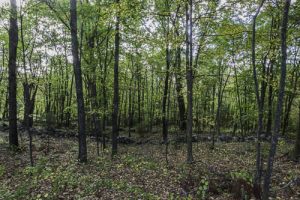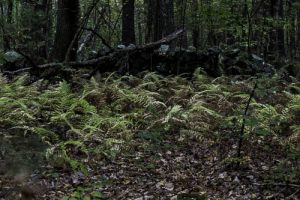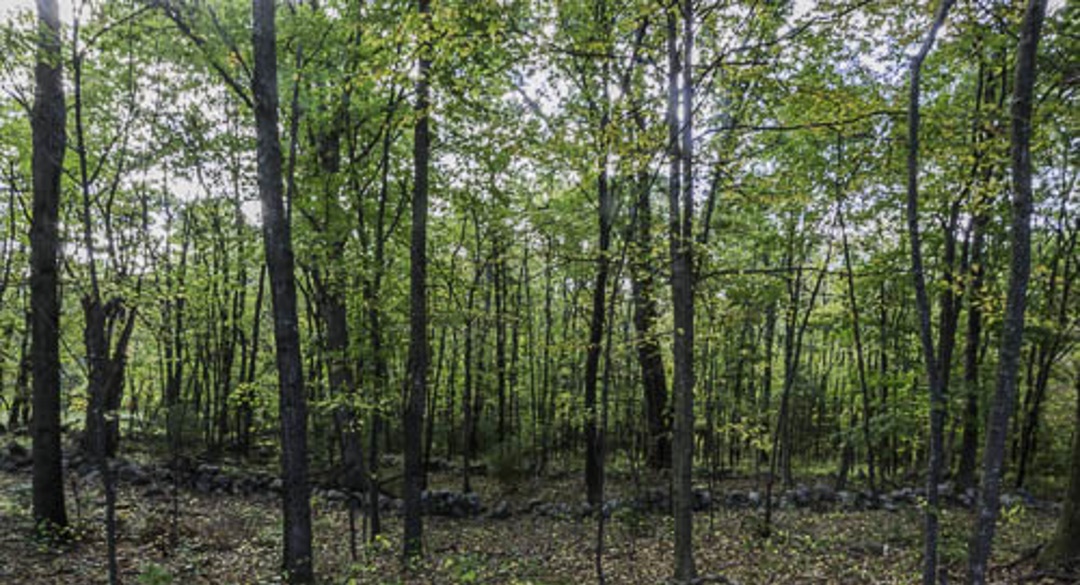Water Closet for October 27, 2017
Just northwest up the road from Middleton in North Andover are Boston Hill and Holt Hill. These glacially deposited and sculpted drumlins at 380 and 420 feet are the highest hills in Essex County. [pullquote]”The land in the last century has gone from grass, to bushes, to trees, which now in mid-October are surprisingly almost all still green”[/pullquote]From these highlands surface runoff of rain and snow-melt plus seeping groundwater flow northeast to Boston Brook and south to Skug Brook, then on to the Ipswich River where they converge with it eleven miles apart. A century ago waters ran off treeless pastures. Now trees cover much of New England. In early- nineteenth century 80 % of Massachusetts was open gardens and pastures. Farmers migrated west where soils are deep. From the hills in any direction one looks, the roads and buildings of the suburbs are largely hidden by trees all the way down to the Boston skyline. Blue Hill, which could be seen south of the city, is also heavily forested. Like the other green hills at a distance it appears blue.
Last Friday, October 13th, a group of seventeen Middleton Council on Aging/Conservation Commission walkers climbed up Boston Hill’s southeast slope and then in a round about way over to Ward Reservation’s unpaved Chestnut Street, now a north-south woodland trail. Beneath magnificent oaks, yellow birches, dying ashes, and a few old white pines they walked in the shade. Sprouts from a few long-gone American chestnuts still alive underground were seen along the path. Their parents lain low a century ago by blight probably once dominated the street. Many of the old oaks were “pasture trees” that without competition spread widely thus providing shade for travelers on this lovely wide street and for livestock just over the walls in the abutting pastures. The old Closeteer, while trying to read the history of the land by its trees, imagined carriages and early 20th century cars on family and courting outings, folks out viewing scenery or picnicking from nearby Lawrence and Andover. In winter there were horse drawn sleighs and children sledding in the high pasture land. All the drumlins’ slopes are pleasantly shaded now by mature trees, mostly oaks. There are no cows, horses, or sheep. The land in the last century has gone from grass, to bushes, to trees, which now in mid-October are surprisingly almost all still green. The two to three rod-wide Chestnut Street is flanked by lichen covered stone walls. Their crevices are the habitats of chipmunks, squirrels, and many other animals largely unseen by groups of happily chatting hikers. Bird songs came up to the hikers from the heavily vegetated brook to the east and from uphill to the west in the pines and oaks. In the fine cool October air all seemed right with the world. No cell phone conversations were heard and the drone of traffic on Routes 114 and 125 became background noise, easily shut out and forgotten. Many thanks must be given to The Trustees of Reservations who keep 700 acre Ward Reservation and its 15 miles of paths free of litter and fallen trees. In three miles the Closeteer on a practice hike found only a baby’s pacifier and a sock to carry out.

Young hardwoods on the lower south slope of Boston Hill, Ward Reservation. Mid-last century this was pasture. The road now blocked by trees was used by farmers and their cattle. – Pamela Hartman photo
The walkers spread out as they leisurely hiked north on Chestnut Street for a mile. They saw no horses, oxen, carts, carriages, bicycles or other people. The large reservation hides other hikers well on its well marked narrow paths. Swales and brooks have sturdy unobtrusive plank walkways over them. The group turned east off Chestnut Street and slowly descended to Boston Brook’s damp stepping stones. The brook was without running water due to a drought with half average monthly rainfall since the end of July. The dark leaves of water-loving spice bushes flanked the rough path in the damp flood plain of the brook. After the brook they slowly ascended Boston Hill southeasterly toward the summit. Several stops were made en route to the handsome 14 acre “barrens” near the top kept free of trees by people with saws and periodic fires in an attempt to reproduce the once common high hill habitat cleared for grazing in colonial times. Before that annual Indian fires kept sun flooded areas open in savannah like wild gardens where certain plants and animal species thrive.

Chestnut Street, Ward Reservation, North Andover. This wide unpaved street for cattle, horse drawn carriages, wagons, and sleighs is now a lovely shaded woodland path flanked by stone walls and old trees. The ferns are turning brown. The tree leaves above this strange fall are still green. – Pamela Hartman photo
Boston Hill’s south sloping barren where clearing was started in 2009 is a place of low plants such as blueberries and switch grass to name only two of scores of species of herbaceous plants and woody bushes partly shaded by a few pitch pines and oaks that had been spared. The Ward Reservation ranger and volunteers installed a dozen or so bluebird houses in the sunny sprout land. Many sprouts grew from each oak stump cut. They’ll be periodically cut. From this handsome wild garden, the group admired the Boston skyline and beyond in an arc spanning east to west. The hikers had come in part for leaf peeping but the rolling land in view from Middleton to Andover was still green with just spots of warmer colors here and there.
For decades the Closeteer had tried to write a fall poem about the color changes. This fall he came up with one he dared share. However, he thought the hike was not the place for a recital. The fall atmosphere on Boston and Holt hills was too precious for mere words. He gave the poem to the Water Closet for inclusion is this account of an outing too early this strange year to see the show.
FALL THEATRE
A million billion actors await high in the wings
Without dressing rooms will change, no shame
Soon the last performance before they fall
Among an audience that admires colors
With final bow the breezes will applaud
Take them for a ride before they reach the ground
When dry there’ll be a last encore
Played with feet, delighting ears with crunchy sounds
People who don’t like them in death’s stately browns
Will rake or noisily blow them into piles
Young children free of such odd thoughts
Will run and jump into crisp crackling arms
Old, wiser now, I leave them ‘neath the trees
Where they should be to feed the soil
To nourish waking buds at next spring’s shows
Old actors never truly die just disappear awhile
And later show their stuff in new green costumes
__________________________________________________________
WATER RESOURCE AND CONSERVATION INFORMATION
FOR MIDDLETON, BOXFORD AND TOPSFIELD
| Precipitation Data* for Month of: | July | Aug | Sept | Oct | |
| 30 Year Normal (1981 – 2010) Inches | 3.89 | 3.37 | 3.77 | 4.40 | |
| 2017 Central Watershed Actual | 3.43 | 1.22 | 2.44 | 0.6 as of Oct 20 | |
Ipswich R. Flow Rate (S. Middleton USGS Gage) in Cubic Feet/ Second (CFS):
For Oct 20, 2017 Normal . . . 8.8 CFS Current Rate . . .1.46 CFS
——————————————————————–
*Danvers Water Filtration Plant, Lake Street, Middleton is the source for actual precipitation data thru Sept.
** Middleton Stream Team is the source of actual precipitation data for Oct…
Normals data is from the National Climatic Data Center.
THE WATER CLOSET is provided by the Middleton Stream Team: www.middletonstreamteam.org or <MSTMiddletonMA@gmail.com>

tashan hello my website is tashan
ibok4d hello my website is ibok4d
Pepe hello my website is Pepe
laptop88 hello my website is laptop88
jostoto hello my website is jostoto
Eagaming hello my website is Eagaming
idc88 hello my website is idc88
js混淆 hello my website is js混淆